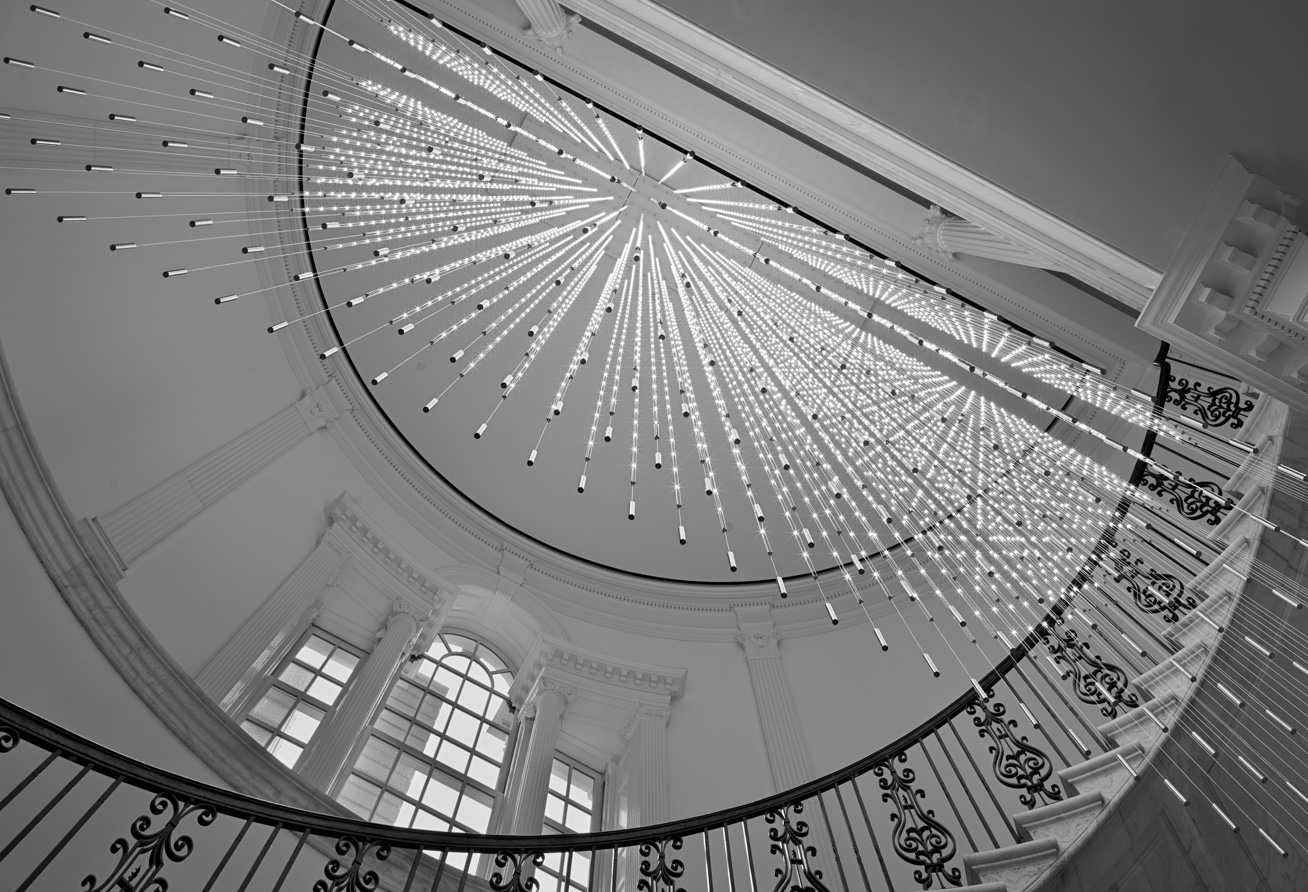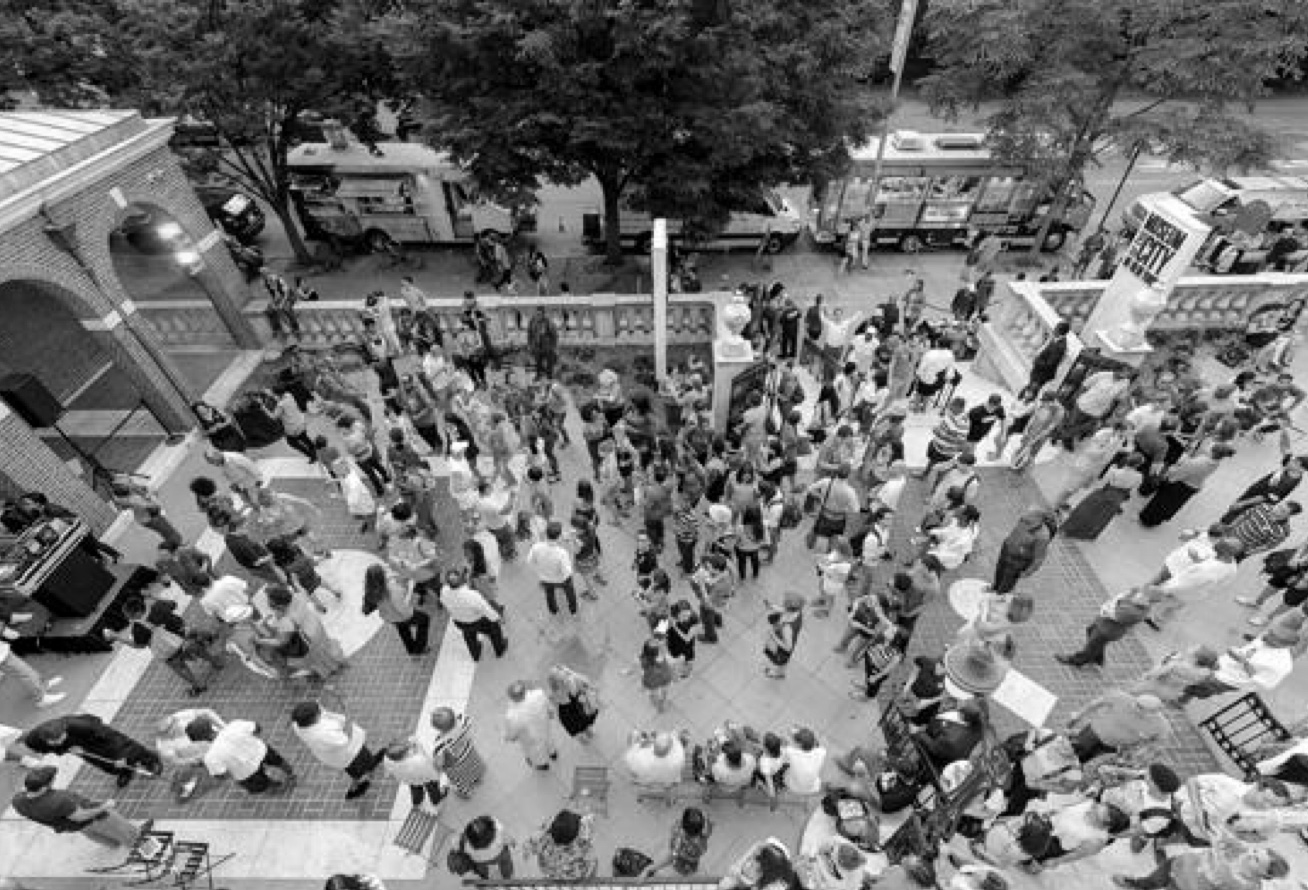Bicycle Advocacy
Love Your Lane
1965-2011

Back to Exhibitions
On April 7, 1973, some 400 cyclists chanting “Bikes don’t pollute” rode through midtown Manhattan in a “Bike-In” that called for separate lanes to encourage bicycling and provide safety on city streets.
Bicycle advocacy had been building since the 1960s, when pioneering activists in American Youth Hostels (AYH) began demanding better and safer street conditions. In the early 1970s, the energy of the growing environmental movement, with its concerns over urban pollution and traffic congestion, fueled the call for a more bike-friendly city.
Grassroots bike activism evolved alongside changes in city government and planning. Bike advocates worked with the mayoral administration of Edward I. Koch during the transit strike of 1980 to facilitate commuting by bike, setting up emergency bike routes on city streets. During the 1980s, bicycle advocacy evolved from a “fringe” grassroots movement to a viable political force influencing city government.
Biking infrastructure has expanded dramatically in recent years. The annual Five Boro Bike Tour, inaugurated in 1977 with 200 riders, has over 30,000 participants today. Mayor Michael R. Bloomberg dramatically expanded cycling in the city by creating hundreds of miles of new bike lanes in Manhattan and Brooklyn between 2006 and 2012, an expansion Mayor Bill de Blasio has vowed to continue across the five boroughs.
While some community members and neighborhood groups have argued that bike lanes add to gridlock and hazards for pedestrians, more New Yorkers use bicycles to navigate the city than ever before.
Meet the Activists
Bill DiPaola


Bill DiPaola
Bill DiPaola founded Time’s Up! in 1987, an environmental organization based in the Lower East Side that focuses on bicycling and community gardens. Time’s Up! campaigns are led by volunteers and often utilize creative and humorous direct action. DiPaula continues to direct the organization.
Image Info: March 30, 2007, Courtesy Brian McGloin.
Paul Steely White


Paul Steely White
Paul Steely White serves as Executive Director of Transportation Alternatives, whose mission is to promote bicycling, walking, and public transit. After its founding in 1973, it shifted much of its focus to lobbying, petitioning, and legal action for environmentally sensitive transit, seeking to shape lawmaking and government regulation of traffic. The group has helped usher in an era of proliferating bike lanes in New York City.
Image Info: Harry Zernike Pictures, 2011, Courtesy Transportation Alternative.
Objects & Images
“Bike-in” Flyer


“Bike-in” Flyer
Advocacy groups such as Action Against Autos and its successor, Transportation Alternatives (1973), raised the public profile of the urban biking movement. Transportation Alternative’s April 1973 “Bike-In” brought 400 cyclists to the streets to urge the creation of exclusive bike lanes in the city. Held on the opening day of the International Automobile Show at the New York Coliseum and celebrated as an “anti-automobile show,” the Bike-In attracted press coverage and public attention.
Image Info: 1973, Courtesy Elliot Winick.
Bike Route Sign From Transit Strike


Bike Route Sign From Transit Strike
During the 1980 transit strike, bike advocates worked with the city to facilitate commuting by bicycle. American Youth Hostel (AYH) posted signs on traffic cones along emergency bike routes. The hotline provided route information and educated callers about the cause of urban bike advocacy. In the words of Elliot Winick of American Youth Hostel, “Instead of protesting and blocking traffic, we had become insiders and part of the system.”
Image Info: April 1980, Courtesy Elliot Winick.
Fabric Patches Supporting American Youth Hostel And The New York Bike Marathon


Fabric Patches Supporting American Youth Hostel And The New York Bike Marathon
The American Youth Hostel in New York supported biking in the 1980s, engaging in actions ranging from supporting the Five Boro Bike Marathon to staging coordinated bike rides that protested cycling bans on New York City streets.
Image Info: Courtesy Elliot Winick.
Five Boro Bike Ride On Sixth Avenue


Five Boro Bike Ride On Sixth Avenue
The Five Boro Bike Tour grew rapidly over the years, from 200 participants in 1977 to tens of thousands today. American Youth Hostel activists were able to “get the message out” about the importance of biking when they obtained corporate sponsorship from Citibank, which has supported the bike tour since 1979.
Image Info: Photographer unknown, 1985, Courtesy Elliot Winick, Photographer unknown.
New York City Department Of Transportation, New York City’s Bicycle Program


New York City Department Of Transportation, New York City’s Bicycle Program
The Koch administration’s Department of Transportation issued New York City’s Bicycle Program in 1983. The report defined three classifications for the city’s existing 130 miles of bikeways: bike paths completely separated from vehicular traffic, striped bike lanes, and bike routes integrated into roadways.
Image Info: March 1983, Courtesy Elliot Winick.
Sign Depicting Bike Lane, Traffic Lanes, And Pedestrian Lane


Sign Depicting Bike Lane, Traffic Lanes, And Pedestrian Lane
In 1987, “guerilla activists” founded Time’s Up!, an organization dedicated to acts of political street theater. This painted cardboard sign from a Time’s Up! event expresses bike activists’ desire to have dedicated bicycle lanes in the city. The group is active today in the causes of bike advocacy and other environmental initiatives.
Image Info: Courtesy Time’s Up Environmental Organization.
“Push Back” Sign


“Push Back” Sign
Time’s Up! has sponsored a range of events, from bike-decorating parties to Critical Mass, a mass nighttime bike ride in which participants symbolically claim city streets. The rides led to confrontations with police, but in 2004, a federal court sided with the bicyclists and forbade the City from shutting down the monthly rides or seizing unattended bikes without evidence of criminal behavior.
Image Info: ca. 2010, Courtesy Time's Up! Environmental Organization.
Time’s Up! Clowns


Time’s Up! Clowns
Time’s Up! activists dressed as clowns and, wearing traffic cone hats, placed fake parking tickets on cars parked in designated bike lanes in 2005 and 2006.
Image Info: ca. 2005, Courtesy Time's Up! Environmental Organization.
Fake Ticket Left On Cars Parked In Bike Lanes


Fake Ticket Left On Cars Parked In Bike Lanes
Times’s Up! uses serious and humorous performances to get its message across. Activists have dressed as clowns and placed these fake tickets on cars to call attention to vehicles parked illegally in bike lanes.
Image Info: Courtesy Time's Up! Environmental Organization.
“Love Your Lane” Stencil


“Love Your Lane” Stencil
Image Info: 2005-2010, Courtesy Time's Up! Environmental Organization.
Bike Lane Opponents And Supporters Gather At The 14th Street Anti-bike Lane Protest


Bike Lane Opponents And Supporters Gather At The 14th Street Anti-bike Lane Protest
Bike lane projects have brought out activists on both sides, as some merchants and property owners have resisted changes to the physical configuration of their streets. One particularly fraught case has been the 2010 conversion of a lane of Prospect Park West to bicycle use. Opponents have mobilized against the reallocation of space, while supporters cite studies showing that the lane has increased safety and bike usage.
Image Info: Zoë Schlanger, October 15, 2010, Courtesy Zoë Schlanger/Gothamist.
Brooklyn Addresses Of Petitions Against Current Ppw Bike Lanes


Brooklyn Addresses Of Petitions Against Current Ppw Bike Lanes
In addition to using traditional flyers and petitions, Neighbors for Better Bike Lanes has used computer-generated graphics to argue that neighborhood residents oppose the expanded bike lane on Prospect Park West. Bike activists have sought to discredit the group as a noisy minority by organizing grassroots demonstrations that dramatize their own strength in numbers.
Image Info: 2011, Courtesy Neighbors for Better Bike Lanes/Seniors for Safety.
Key Events
| Global | Year | Local |
|---|---|---|
|
Ralph Nader’s book Unsafe at Any Speed feeds environmentalist criticism of automobiles |
1965 | |
| 1966 |
Mayor John V. Lindsay closes Central Park to automobile traffic on weekends |
|
| First Earth Day celebrated nationwide | 1970 |
|
|
Transportation Alternatives formed as a coalition of advocates for non-automotive and mass transit; holds first “Bike In” |
1973 |
|
| 1977 |
First Five Boro Bike Challenge |
|
| 1980 | Two bike lanes created in Manhattan during transit strike; later eliminate | |
| 1987 | Time’s Up! environmental organization founded in New York |


